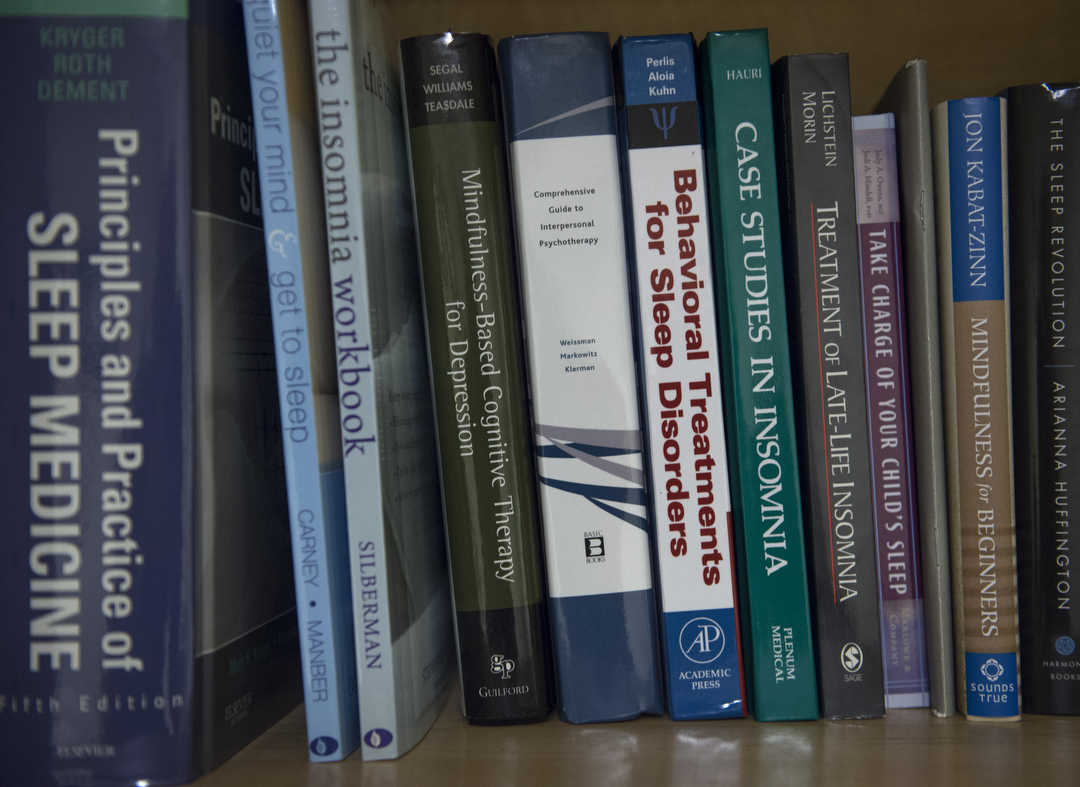It’s early morning. Not “look-at-that-heavenly-golden-sunrise” morning, but “oh-dear-God-please-let-me-go-to-sleep” early morning.
Since midnight your thumbs have been flitting feverishly over your smartphone. You loiter on Facebook and Pinterest a while before settling on Netflix, through which you scroll for an entire hour without ever watching a movie.
Somewhere between 1 a.m. and 5 a.m., depending on the severity of your disorder, you finally put down the phone and heave an exasperated sigh. You stare at the ceiling, vacant and wild-eyed, pleading for slumber.
You start to fret about all you must do tomorrow. You fret about not sleeping. You fret about functioning like the walking dead.
You’ve been here before, too many times.
You have a prescription for just this occasion.
You think about using it.
But wait.
For just a moment, shelve the cell phone, quiet your thoughts and hold off on that pill.
Spectrum Health clinical psychologist Leisha Cuddihy, PhD, knows a way to find that elusive slumber.
Less medicine
With most patients, medication can be avoided if you catch any problems early enough, Dr. Cuddihy said.
There are times when it’s necessary, of course.
“Sometimes (a problem) can get so chronic and severe—or sometimes there are other medical conditions that may be contributing—that medications may be more appropriate,” she said.
But with sleep disorders that arise from an accumulation of bad habits, psychology can help disentangle the mind.
Dr. Cuddihy specializes in cognitive behavioral therapy for people suffering from insomnia.
“I think everybody, no matter whether they end up using medication, could benefit from behavioral strategies,” she said. “It’s always better to try that first, because once you’re on a medication it’s a lot harder to get off it.”
It’s no surprise Americans can be an anxious bunch, a problem that makes them prone to sleep disorders. It’s also no mystery that people turn to medications to solve some problems when sometimes they shouldn’t.
Medications can take patients down complicated paths, Dr. Cuddihy said.
“A lot of times, people develop a tolerance (to medication),” she said. “They don’t work as well as they did, so they need higher doses, or they have to try several different things.”
With sleep disorders in particular, the American College of Physicians advises patients to try cognitive behavioral therapy before trying medication.
“Most patients I see have tried or are already on some kind of medication,” she said. “A lot of times I can help them reduce their dose or get off the medication completely.”
Dr. Cuddihy said she can help patients pinpoint the habits or behaviors they’ve developed over time that have kept them from getting a good night’s sleep. By learning to change these habits, they remove the obstacles to sleep.
More therapy
The treatment process begins with a journal.
About two weeks before the first appointment, the patient starts a nightly sleep log that documents their sleep quality and habits. The log is kept throughout the treatment, typically four to six visits spread over a few months.
Lights out
If you want to ensure an optimal sleep routine—before you fall into any bad habits—Dr. Leisha Cuddihy offers some tips.
“These types of tips aren’t necessarily going to help people who already have a chronic insomnia problem,” Dr. Cuddihy said. “These tips are more preventive. They’re good habits to have that could potentially help you avoid developing an insomnia problem.”
Try these approaches
- Turn off electronics. This includes cell phones, tablets, TV, any technology. It’s best to keep this stuff out of the bedroom altogether. Dr. Cuddihy’s ironclad rule: “An hour before bed, all that should be turned off and not turned on again until you wake up in the morning.”
- Set a sleep schedule. Go to bed at the same time each night and wake up at the same time every morning.
- Make a list. Hours before bed, purge your mind of what you suspect will nag at you in bed. Write down the shopping list for tomorrow, the to-do items, the bright idea you’ve been tossing around. Don’t take those thoughts to bed.
- Quiet your mind. Practice mindfulness—be present in the moment and let go. “It’s one of the skills I sometimes teach patients who are having a lot of racing thoughts,” Dr. Cuddihy said. “Instead of honing in on those thoughts and following them where they go, separate yourself from them and focus internally on your breathing.”
The more complex the patient, the longer the treatment.
“If someone asks me to help them, with a physician, to reduce medications, that tends to take a little longer,” Dr. Cuddihy said. “Or if they have a chronic pain issue it may take longer to see change.”
It’s rare to see someone past eight to 10 visits, she said. A six-visit plan is the norm.
“People usually start seeing improvements within the first month or two of treatment,” she said.
Dr. Cuddihy develops individual treatment plans based on the problematic habits and behaviors she sees in each patient.
“It’s using their existing sleep pattern and sleep information to inform precisely what we’re going to do,” she said.
In most cases, patients suffer from insomnia, which can develop for any number of reasons.
“Stress, obviously, and relationships—all that stuff plays into sleep,” the doctor said.
Take anxiety. It’s just one thing that can cause insomnia. And there are infinite causes of anxiety itself—finances, workplace politics, family issues, personal health.
“Really, anything can initiate a sleep problem,” Dr. Cuddihy said. “Even something as little as a cold could sometimes be a trigger.
“There’s nothing I could tell you for women versus men or young versus old,” she said. “It’s pretty much, if you have things on your mind, that’s what happens when you try to sleep.”
When the triggering problem first arises, a person’s mindset gives rise to habits and behaviors that lead to chronic sleep disorders such as insomnia.
Even long after the problem itself has passed, the habits persist: Going to bed extra early in hopes of catching up on missed sleep, but never actually falling asleep. Napping during the day. Sleeping all weekend long. Nosing over the cell phone ’til 4 a.m.
“Most of the time, by the time people get to me, that trigger isn’t really an issue anymore,” the doctor said.
That’s when cognitive behavioral therapy is effective.
“Cognitive is dealing with some of the thinking, behavior is dealing with some of the behaviors and habits,” she said. “There are multiple pieces of the puzzle.”
Plenty of skills
Anxiety, and sometimes medications, loom large in the world of sleep.
“I’m not anti-medication,” Dr. Cuddihy cautioned. “But it’s a quick fix, and most quick fixes are not the best ones. If you can get away with learning to deal with something without taking medication, why wouldn’t you do that instead?”
Cognitive behavioral therapy is harder, she said—certainly a lot harder than popping a pill every night.
“If you stop taking that pill, it’s going to stop working,” Dr. Cuddihy said. “Once you leave treatment with me, you know what to do the next time you have trouble sleeping. You carry that with you the rest of your life.”
Beyond identifying and erasing bad habits, insomnia therapy can help people develop alternative strategies to combat incessant wakefulness.
They begin by developing daytime habits—cutting caffeine or other substances, as a simple example—and they establish nighttime habits conducive to a restful mindset.
“It does involve setting a sleep schedule … and sometimes strategies for managing unhelpful thinking or anxious thinking,” Dr. Cuddihy said.
For example: You lie awake in bed, agonizing about all that tomorrow holds.
“The first thing I would say is you don’t do that in your bed,” she said.
The alternative: “A couple of hours before you go to bed, make your list for that next day,” Dr. Cuddihy said. “So if that (worrying) happens, you can tell yourself in bed, ‘I have it on the list. I don’t need to worry about it right now.’”
Another common mindset that causes sleeplessness is panic about sleeplessness itself, she said. In virtually every instance, the reality is not as bad as imagined.
“How many bad nights of sleep have you had, and how many days have you not been able to function?” Dr. Cuddihy said. “Chances are, the things you were worried are going to happen—in the middle of the night, when you should otherwise be sleeping—are not really going to be that close to what actually is going to happen or has happened in the past.”
She explained: “Over the past 100 days, how many have you had insomnia? ‘Well, 90 of them.’ How many days have you not been able to function? Probably none.
“So, you’re really worried about something that’s minimally likely to happen,” she said. “That’s not to say that your day isn’t going to be awful, but you’ll probably get done what you need to get done.”
Cognitive behavioral therapy helps you “walk through, a little more rationally, some of those panicky thoughts you might have,” she said.
It essentially helps a patient re-train their brain.
“In their effort to improve their own sleep, they have unintentionally taught their brains and bodies the wrong things,” Dr. Cuddihy said. “The treatment is helping to reverse that learning to retrain the body to sleep the right way.
“It’s a skill, really,” she said.








 /a>
/a>
 /a>
/a>
 /a>
/a>